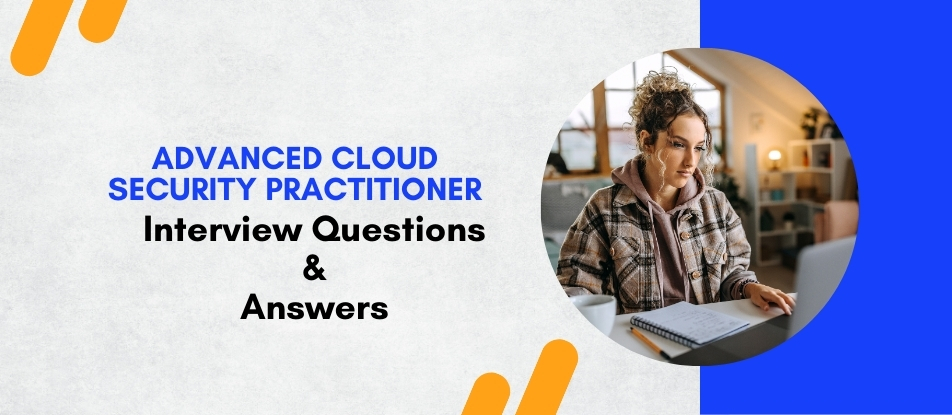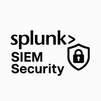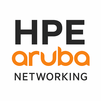
Gain cutting-edge skills in cloud security with our Advanced Cloud Security Practitioner course. Designed for experienced IT professionals, this training explores sophisticated topics like forensic analysis, quantum-resistant cryptography, and the integration of AI in security practices. Learn from industry experts on how to design and implement comprehensive security policies across various cloud platforms, ensuring maximum protection against advanced persistent threats and achieving compliance with global standards.
Advanced Cloud Security Practitioner Interview Questions Answers - For Intermediate
1. Explain the concept of endpoint security in cloud computing.
Endpoint security involves securing end-user devices that access cloud services. This includes the use of antivirus software, personal firewalls, and advanced threat protection solutions to prevent malicious activities originating from these devices.
2. What is the significance of logging and monitoring in cloud security?
Logging and monitoring are essential for detecting, understanding, and responding to security incidents. They provide detailed insights into the activities within cloud environments, helping to identify potential security breaches or compliance issues.
3. How do you handle security incident response in a cloud environment?
Security incident response in the cloud involves a coordinated approach to address and manage the aftermath of a security breach. This includes identifying the incident, containing the damage, eradicating the root cause, and recovering systems to normal operation.
4. What are DDoS attacks and how can they be mitigated in cloud environments?
Distributed Denial of Service (DDoS) attacks involve overwhelming a service with excessive traffic to make it unavailable. Mitigation in cloud environments often involves scalable infrastructure to absorb the traffic and filtering systems to block attack traffic.
5. What role do firewalls play in cloud security?
Firewalls serve as a barrier between secure internal networks and untrusted external networks, such as the internet. They filter incoming and outgoing traffic based on predetermined security rules to prevent unauthorized access to network resources.
6. Discuss the importance of patch management in cloud security.
Patch management is crucial in maintaining security by applying updates to software and systems that fix vulnerabilities. Regular patching helps prevent cyber attackers from exploiting known vulnerabilities to breach cloud systems.
7. What is multi-factor authentication (MFA) and how does it enhance cloud security?
Multi-factor authentication requires users to provide multiple forms of verification to access cloud resources, typically combining something they know (password), something they have (security token), and something they are (biometric verification). This significantly reduces the risk of unauthorized access.
8. How does container security differ from traditional cloud security?
Container security focuses on securing containerized applications and their underlying infrastructure, including the container runtime and orchestration. It requires specific strategies like container-specific vulnerability management and network segmentation.
9. What is data sovereignty and how does it impact cloud computing?
Data sovereignty refers to the legal requirements that data is subject to the laws of the country in which it is stored. In cloud computing, this impacts decisions about where data is stored and processed, and how it is protected in accordance with local laws.
10. Explain how encryption keys are managed in the cloud.
Key management in the cloud involves generating, using, storing, and deleting encryption keys securely. Best practices include using dedicated key management services that ensure keys are handled securely and are not exposed to unauthorized entities.
11. What are the security implications of serverless computing?
Serverless computing poses unique security challenges, including increased difficulty in visibility and control, reliance on third-party security practices, and vulnerabilities in the execution environment. Addressing these requires a focus on secure application development and third-party security assessments.
12. How do you ensure secure data storage in the cloud?
Secure data storage involves encrypting data at rest, using robust access controls, and implementing redundant storage to protect against data loss. Regular security audits and compliance checks are also vital to maintaining data security.
13. What are the best practices for securing a cloud migration?
Securing a cloud migration involves comprehensive planning, data encryption during transfer, using secure APIs, implementing access controls, and continuously monitoring for security threats throughout the process.
14. What is the role of artificial intelligence in cloud security?
Artificial intelligence enhances cloud security by automating complex processes such as threat detection, behavior analysis, and real-time security updates. AI can identify patterns that indicate potential security threats faster and more accurately than traditional methods.
15. Discuss the significance of a business continuity plan (BCP) in cloud environments.
A business continuity plan is essential in cloud environments to ensure that operations can continue with minimal disruption in the event of a major incident. It involves strategies for data backup, system recovery, and maintaining critical operations under various scenarios.
Advanced Cloud Security Practitioner Interview Questions Answers - For Advanced
1. What are the specific security concerns associated with the use of multi-cloud strategies, and how can they be mitigated?
Multi-cloud strategies involve using multiple cloud services from different providers, which can lead to complex security challenges such as inconsistent security policies, increased complexity in identity and access management, and difficulty in achieving end-to-end visibility. Mitigating these concerns requires implementing a unified security management and governance framework that spans all cloud services, employing cross-cloud security tools that can integrate with different cloud platforms, and ensuring consistent security policies are applied across all environments. Additionally, using a central identity management solution can help manage access across different clouds effectively.
2. Discuss the security implications of quantum computing on cloud encryption and what preemptive measures can be taken.
Quantum computing poses significant security implications for cloud encryption, particularly threatening current cryptographic algorithms that rely on the difficulty of factoring large numbers, a task that quantum computers can potentially perform efficiently. Preemptive measures include developing and transitioning to quantum-resistant cryptographic algorithms, which are not susceptible to quantum computing attacks. Organizations should start planning for a post-quantum cryptography era by assessing their current cryptographic infrastructure, identifying areas most at risk, and beginning to implement quantum-resistant algorithms in a phased approach.
3. How should cloud security be managed in an Internet of Things (IoT) integrated environment?
Managing cloud security in an Internet of Things (IoT) integrated environment requires a multi-layered approach due to the increased complexity and scale of the network. First, strong authentication and encryption should be implemented to secure the data transmitted between IoT devices and the cloud. Network segmentation is also crucial to isolate critical devices and data from other network traffic, reducing the potential impact of a breach. Additionally, continuous monitoring of device behavior to detect anomalies and potential threats is essential. Implementing robust security policies for device management, including regular updates and patches, and ensuring that security measures are scalable to handle a large number of connected devices are key strategies for maintaining security in IoT-integrated cloud environments.
4. What are the best practices for disaster recovery planning in cloud computing?
Best practices for disaster recovery in cloud computing include conducting regular risk assessments to identify critical assets and potential threats, designing redundant systems and data backups across multiple geographic locations to ensure availability, and implementing automated failover processes to minimize downtime. Detailed and regularly updated recovery plans should clearly outline roles and responsibilities, recovery procedures, and communication strategies during a disaster. Regularly testing disaster recovery plans to ensure they are effective and that personnel are familiar with the procedures is also crucial. Additionally, leveraging cloud-native features such as scalability and flexibility can enhance the resilience and responsiveness of disaster recovery strategies.
5. Evaluate the effectiveness of software-defined networking (SDN) in cloud security.
Software-defined networking (SDN) can significantly enhance cloud security by providing centralized control over network traffic and more dynamic and adaptive security configurations. SDN allows network behavior to be programmatically controlled through centralized software, which can improve visibility and make it easier to implement and update security policies. This centralized control can also facilitate more efficient segmentation, isolation, and management of traffic flows, which are critical for containing security breaches and mitigating threats. However, the security of the SDN itself is crucial, as it becomes a potential single point of failure. Therefore, robust security measures, including encryption of control channels and strong authentication mechanisms, must be implemented to protect the SDN infrastructure itself.
6. Discuss the role of compliance frameworks in cloud security.
Compliance frameworks play a crucial role in cloud security by providing standardized guidelines and best practices that help organizations protect their data and comply with legal and regulatory requirements. Frameworks such as ISO/IEC 27001, NIST, and GDPR outline specific security measures and controls that organizations should implement to manage risks and safeguard sensitive information. Adhering to these frameworks can help organizations maintain customer trust, avoid legal penalties, and ensure consistent security practices across their cloud deployments. Additionally, compliance with these frameworks often requires regular audits and assessments, which can help organizations identify and address security gaps in a timely manner.
7. How can machine learning be used to enhance cloud security?
Machine learning can enhance cloud security by automating the detection of and response to security threats and anomalous behavior. Machine learning algorithms can analyze large volumes of data from network traffic, user activities, and system logs to identify patterns indicative of malicious activities that might be missed by traditional security tools. Once trained, these models can predict potential security breaches and automate responses, such as isolating affected systems or blocking suspicious activities. Furthermore, machine learning can optimize security resource allocation by learning from past incidents, thereby enhancing the overall efficiency and effectiveness of cloud security measures.
8. What are the implications of shadow IT in cloud computing, and how can it be managed?
Shadow IT in cloud computing refers to IT systems and solutions built and used inside organizations without explicit organizational approval. It poses security risks because these systems may not comply with organizational security policies and could expose sensitive information to threats. Managing shadow IT involves first identifying all unauthorized cloud services and applications in use. Once identified, organizations should evaluate the risks associated with these services and either integrate them into the official IT environment with appropriate security controls or prohibit their use.
9. How does federated identity management contribute to cloud security?
Federated identity management contributes to cloud security by allowing organizations to manage and share identities across different systems and organizations without needing to store and manage separate credentials for each service. This reduces the number of attack vectors, as user credentials are not repeatedly stored across multiple platforms, which can be a target for cyber-attacks. It also enhances user experience by providing seamless access to multiple applications through single sign-on (SSO). For cloud environments, it ensures that security policies concerning user authentication and access controls are consistently applied across various cloud services, enhancing overall security posture.
10. Discuss the security considerations when implementing a cloud-native application development strategy.
Implementing a cloud-native application development strategy involves specific security considerations to ensure that applications are protected throughout their lifecycle. This includes integrating security into the DevOps process (DevSecOps), where security testing and compliance checks are automated and integrated into the continuous integration/continuous deployment (CI/CD) pipelines. Additionally, using containerization and microservices architecture requires securing each component individually, as well as the communications between them. Robust authentication and authorization mechanisms, encryption of data in transit and at rest, and rigorous monitoring and logging of all activities are also crucial.
11. What are the best practices for handling insider threats in a cloud environment?
Handling insider threats in a cloud environment involves a combination of technical controls, policies, and training. Best practices include implementing least privilege access controls to ensure employees have only the permissions necessary for their roles. Regular audits and reviews of user activities and access rights can detect and mitigate unauthorized or inappropriate actions. Additionally, using user and entity behavior analytics (UEBA) tools can help identify abnormal behavior patterns that might indicate insider threats. Comprehensive training programs that educate employees about security policies, the importance of data protection, and the consequences of policy violations are also crucial. It's also recommended to establish clear incident response protocols to quickly address any actions related to insider threats.
12. How do privacy-enhancing technologies apply to cloud security?
Privacy-enhancing technologies (PETs) apply to cloud security by enabling data to be processed and utilized without compromising privacy. Techniques such as differential privacy, which adds noise to data to prevent identification of individuals, and homomorphic encryption, which allows data to be processed in its encrypted state, are vital in contexts where data privacy is paramount. These technologies ensure that cloud services can utilize data for analytics and machine learning while still adhering to strict privacy standards and regulations.
13. Explain the challenges of securing Big Data in the cloud and strategies to overcome them.
Securing Big Data in the cloud presents challenges due to the volume, velocity, and variety of the data being processed and stored. These challenges include ensuring data privacy, maintaining data integrity, and managing access controls. Strategies to overcome these challenges involve implementing robust encryption methods for data at rest and in transit. Additionally, data anonymization techniques can be used to protect individual privacy without compromising the utility of the data. Employing advanced monitoring and real-time security analytics can also help detect and respond to threats quickly. Finally, creating comprehensive data governance policies that define data access, data sharing, and data retention rules is crucial for maintaining overall data security.
14. What role does cloud access security brokers (CASBs) play in cloud security?
Cloud Access Security Brokers (CASBs) play a critical role in cloud security by acting as intermediaries between cloud service consumers and providers to enforce security policies. CASBs provide visibility into cloud application usage, protect against unauthorized access, and prevent data leaks by monitoring data traffic and user activities. They also offer features such as encryption, tokenization, and access control, making them crucial for organizations that use multiple cloud services. By implementing CASBs, organizations can extend their security policies beyond their local infrastructure and gain the tools necessary to manage security across various cloud platforms effectively.
15. Discuss the importance of secure software development lifecycle (SDLC) practices in cloud-based application development.
Secure SDLC practices are crucial in cloud-based application development to ensure that security considerations are integrated at every phase of the application lifecycle. This approach involves defining security requirements in the planning stages, implementing secure coding practices during development, and performing rigorous security testing during the testing phase. Additionally, during deployment, automated security checks should be integrated into the deployment pipelines to prevent insecure code from being released. After deployment, continuous monitoring and regular security audits help identify and mitigate any new vulnerabilities that may arise. By adhering to secure SDLC practices, organizations can reduce vulnerabilities, comply with regulatory requirements, and protect user data effectively, ultimately leading to more secure cloud-based applications.
Course Schedule
| Dec, 2025 | Weekdays | Mon-Fri | Enquire Now |
| Weekend | Sat-Sun | Enquire Now | |
| Jan, 2026 | Weekdays | Mon-Fri | Enquire Now |
| Weekend | Sat-Sun | Enquire Now |
Related Courses
Related Articles
- Mastering Azure: Essential Skills You Need to Succeed
- Earn Instructor-Led Online Training for SAP® ABAP
- Introduction to AVEVA E3D and Its Role in Plant Design
- PDMS Training and Certification: Why it's Important for Career Growth
- Explaining Main Elements of Microcontroller - PIC Microcontroller Programming Training Course
Related Interview
Related FAQ's
- Instructor-led Live Online Interactive Training
- Project Based Customized Learning
- Fast Track Training Program
- Self-paced learning
- In one-on-one training, you have the flexibility to choose the days, timings, and duration according to your preferences.
- We create a personalized training calendar based on your chosen schedule.
- Complete Live Online Interactive Training of the Course
- After Training Recorded Videos
- Session-wise Learning Material and notes for lifetime
- Practical & Assignments exercises
- Global Course Completion Certificate
- 24x7 after Training Support















 Join our Live Instructor-Led online classes delivered by industry experts
Join our Live Instructor-Led online classes delivered by industry experts